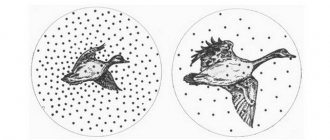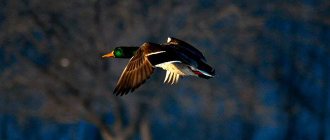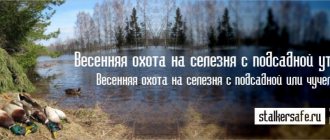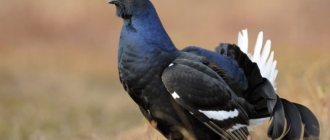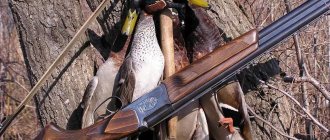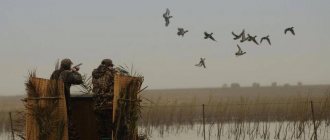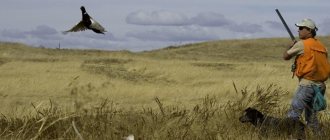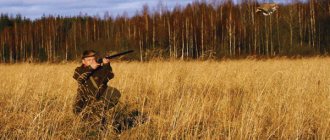Rules for duck hunting in autumn
It is necessary to take into account the specifics of the autumn behavior of waterfowl, namely:
- active feeding leads to an increase in the fat layer, fluff and feathers;
- gregariousness;
- caution;
- changing periods of activity.
Seasonal environmental changes also contribute. In this regard, the hunter must:
- increase the amount of gunpowder and shot caliber to produce a lethal shot;
- behave extremely quietly so as not to frighten the birds;
- think over camouflage, because flying leaves and withered grass perfectly unmask the hunter.
Preparing for duck hunting in the fall
Preparation includes not only the selection of equipment, disguise and weapons. What does a hunter need to know?
- appearance of birds that are allowed to be hunted in the area;
- features of the terrain, habitats of birds (so that you don’t have to wander for a long time in search of game);
- features of bird behavior;
- hiding places (or places where hiding places can be placed).
You also need to hone your shooting skills. Especially if you don't hunt often.
Attention! There are species of ducks listed in the regional or national Red Book. Hunting them is strictly prohibited.
Disguise
Ducks have excellent eyesight, so camouflage is vital. The following can serve as camouflage:
- camouflage suits;
- camouflage suits such as “kikimora”, “goblin”;
- scrim;
- ambushes (secrets).
In turn, there are different types of concealments: industrial-style and home-made.
Industrial:
- huts;
- umbrellas;
- recumbent hides;
- tents;
- sitting hides (chair).
A camouflage suit must be chosen with a small pattern. The color of the camouflage should match the terrain in which you will be hunting.
Remember! For camouflage among dry grass or reeds, you should take a light camouflage, and for a swamp, a brown-green color.
It is necessary to camouflage both the gun and the boat if hunting is carried out from the water.
Habits of wild ducks
Wild ducks are one of the main objects of hunting. They are traditional game for hunters who shoot in floodplains and near lakes. In the summer, ducks are shot from the approach, scaring them away from their homes and driving them out of impassable thickets. In more open bodies of water, where there is no abundant and dense vegetation, hunting is carried out directly from boats. In both the first and second cases, in deep water, shot game is caught from the water by specially trained dogs. In shallow water, where there is simply marshy terrain or something like water meadows (especially in floodplains), you can pick up a duck yourself.
Often, a wild duck protects fledgling chicks: when the mother screams, the alarmed young usually rush into the thickets of cattails and reeds or dive under the water, finding salvation there from the approaching danger, and she herself often at this time takes the hunter’s dog far away from them.
Where wild ducks are not persecuted, they happily settle close to human habitation, occupying places in the ponds of city parks, on rivers, and on mill dams. Compared to other species of ducks, the mallard, with good protection on the land, quickly grows in numbers, which ultimately provides more game for the next hunting season.
Author: Elena Tikhonova
Article protected by copyright and related rights. When using or reprinting material, an active link to the men's magazine manorama.ru is required!
Continued>>
Duck hunting: choosing decoy ducks
Capercaillie hunting Hunting for wild pigeons Hunting for wading birds: snipe Basic methods and principles of hunting goose Hunting for corncrake The most common breeds of hunting dogs
Features of autumn hunting
In autumn, lines of birds flock to warmer regions, so the hunter can catch not only the duck common to his area, but also its northern relatives. Sometimes, on calm ponds, bird colonies of various species of waterfowl are formed.
Where to look for ducks in the fall
Ducks prefer freshwater bodies of water with dense, tall vegetation - reeds and cattails. The bird uses shallow reservoirs for daytime and rest, but it feeds in deeper reservoirs. The next thing you should know is to ask the locals, carefully observe on your own where exactly in this body of water the birds feed.
Habits of a duck in autumn
In autumn, ducks are more careful and behave suspiciously. They have already gathered in large flocks for migration, so the chance that the hunter will be noticed by someone from the duck flock increases. Therefore, extreme caution should be taken.
Birds feed at sunset, sometimes at night, and during the day they rest in secluded places. Fattening time occurs approximately in the last hour before sunset and an hour or two before sunrise.
Hunting on flights
In the last month of summer, wild ducks begin long flights to feeding areas. They usually choose the same path. Ducks take to the air at sunset and feed all night. The birds return back at dawn.
It is important to find out where ducks gather for migration. They move in flocks at low altitudes. If the hunt takes place at sunset, it is important to take care of camouflage. At night, a bright fire can cover the hunter. In the evening, you can shoot at flying birds, and in the morning, use stuffed animals and decoys in places where birds stop to rest.
You should not hunt ducks in places where fattening occurs, otherwise the birds will never return there again. The best time to hunt is on rainy days when ducks are flying low. It is worth shooting when the bird is above the hunter. It is at this moment that you have the best chance of getting there. If the wind is strong, the hunter may jump up just at the moment when the birds are blown towards him. At this moment, the ducks get scared, begin to flicker and flock together. Then you can shoot. You should shoot at one specific target, and not at the entire flock. Injuring a large number of ducks can cause a significant reduction in the flock.
Thus, knowing all the features of duck hunting in the fall, you can count on good catch. It is at this time of year that ducks gather in flocks to fly to warmer climes, and they also gain weight. The most effective way is to hunt with a dog. The four-legged friend is not only able to drive the bird towards the owner, but also to find and bring back wounded prey. The hunting method should be chosen based on your own experience, accuracy and available equipment.
Hunting methods
Hunting methods vary. There is: from a boat;
- from the shore;
- chassis;
- with a dog;
- with stuffed animals;
- with semolina;
- with a decoy;
- on flights.
With stuffed animals
Hunting with stuffed animals is a fairly common method, especially nowadays. The stuffed animals are seated at a distance of at least 2-3 body lengths from each other - this is how the ducks are positioned when everything around is calm.
The hunter camouflages himself in a hidden area and waits until a flying flock, having noticed the scarecrows, goes down to the water to feed. Usually this is a morning hunt.
From the approach
Approach hunting requires more skill. The hunter must find the ducks hiding there in the thickets of reeds or grass, approach them at close range, scare them off, and shoot them in mid-air. To return with prey, you need to know about places where the desired game can hide, be able to walk a lot and quietly, camouflage well and shoot accurately.
With decoy
A duck call imitates the cry of a duck, so flying flocks, hearing it, descend onto the water. However, you also need to be able to work with a decoy. Before hunting, novice decoys must learn the “duck alphabet”, breathe correctly and decoy.
When hunting, you should not “quack” all the time. The simplest and most uncomplicated call is short, loud, and at regular intervals.
With a decoy
As the name implies, a decoy duck will lure prey. She, unlike silent stuffed animals, quacks, thereby attracting wild relatives.
Remember! Drakes that land on a decoy should be shot so as not to hit your duck.
The decoy should have a loud, clear voice and a color that should closely resemble its wild relatives. The method works great with two decoys that are planted so that they cannot see each other. However, they hear, and therefore actively “talk.” The bait is “tied” in shallow water so that it does not float away far.
From the boat
When walking hunting is not possible, a boat is used. Hunting from a boat requires the following skills:
- silently steer the boat using oars and a pole;
- searching for ducks;
- accurate shooting, despite unfavorable conditions.
Usually there are two people hunting from a boat: one controls, the other stands ready with a gun. You should move against the wind. It is very important to remember about safety precautions in order to avoid accidents or “swimming” in a pond. Moreover, after such water procedures the gun will be lost.
Mistakes when hunting ducks with stuffed animals
For some hunters, especially inexperienced ones, hunting with decoys does not always go as desired. Some blame it on the “capriciousness” of the quacking brethren, others on lack of luck. But often, an empty bag is simply a consequence of some mistakes.
- Wrong place and wrong weather Hunters don’t have to choose the weather. This is where the first mistake appears - inconsistency with weather conditions and terrain. During autumn hunting, the most successful weather is considered to be cloudy and windy, when the wind drives waves. Because of this, the birds have to literally rush around the pond. But if the weather is warm and windless, then the ducks circle in one, open place. It is very difficult to get close to them in such conditions. Therefore, there are two options: try to scare them away or lure them with a decoy. There is a possibility that the flock will approach the placed scarecrows.
- Not the place for scarecrowsIt must be remembered that stuffed mallards and teals are placed in shallow water, and stuffed ducks are placed in deeper water. In addition, you cannot mix them, because in nature these types of ducks stay apart from each other. If the wind is sideways, then the stuffed animals must be placed a little away from the hiding place or hut. After all, birds land on the water or take off against the wind. So the ducks will fly past the scarecrows and sit right in front of the hunter. It makes no sense to place decoys in a straight line from the hunter. The prey will still splash down to the side.
If the hunter has chosen a hiding place on the leeward side, then in this case the stuffed animals should be placed closer to the shore. But you need to be prepared that the ducks will be very close.In general, 25 meters is considered the most convenient distance from the scarecrow to the hunter. If you place them further, then you will have to use binoculars instead of a gun.
Some hunters use a peculiar trick - not far from the stuffed ducks they place a stuffed seagull or a crow on a long stick. It turns out to be a kind of signal to a flock of waterfowl that there is no danger.
- Too densely spaced stuffed animals Interesting fact: in nature, ducks never stay close to each other. The flock spreads across the pond in search of food. Birds cluster only in case of danger. Therefore, there is no need to make the common mistake of placing stuffed animals close to each other. Otherwise, wild ducks, having caught the silent signal, will feel alarmed and fly past. So you need to place the stuffed animals in small groups of 4-6 pieces, a meter apart from each other. The distance between “groups” must be at least four meters.
- Lack of a “landing area” When arranging scarecrows, it is important to take into account the presence of a “landing area” for birds. For example, if the dummies are in circles or ovals, then the ducks will not like it. Most likely, they will simply circle and fly away. The flock most willingly splashes down in those places where there is a large area and a pocket on the leeward side. So it is best to place scarecrows on the pond in the shape of the English letters J or V.
- Poor appearance of stuffed animals During the hunting season, you need to monitor the condition of stuffed animals. Particular attention should be paid to the so-called shiny dummies. If this is found, then it is better not to use it. After all, unnatural shine will scare away birds. You can try to revive such an unusable stuffed animal - paint it with matte paint. Stuffed animals should be transported in special bags and thoroughly cleaned from dust and dirt after each hunt. You cannot leave stuffed animals on the water overnight. Morning fog or dew will cover them with a film, and the whole hunt will go down the drain. By following these simple rules, autumn duck hunting will become more successful and bring a lot of pleasure.
How to shoot a duck in the fall
Autumn hunting is somewhat different from summer. In autumn, ducks are covered with a layer of subcutaneous fat, they have down, and the number of feathers has increased. Accordingly, all this is an additional obstacle for the fraction.
Gun
When hunting ducks, they use guns with a barrel length of up to 80 cm, choke and poluchok constrictions. Such a gun allows the hunter to catch game at a considerable distance.
Caliber
The best option for duck hunting is 12 gauge. It is preferred due to the sharpness of the battle for maximum destructive power. Otherwise, the bird can only be wounded and it will fly away.
Cartridge
When loading a cartridge, use shot No. 4-7 depending on the size of the duck and the hunting season. In the autumn, when the birds have gained fat and acquired a solid down and feather robe, they use shot Nos. 3 and 4.
Also in connection with this, it is necessary to increase the amount of gunpowder. The size of the sample depends on the brand of gunpowder. For example, when using the Sokol brand, the weight will be 0.25 grams.
Home, hunting,Duck hunting G.E.
Rakhmanin , Methods of hunting Summer
Hunting on morning and evening flights
Tag: hunting for drakes for decoy, Hunting from the approach to take off, Hunting from a smooth hist, Hunting from the approach to take off, hunting with decoys and stuffed animals in the summer, Hunting on morning skids, Hunting on flyways, Hunting from the entrance and approach in the fall, Hunting with locusts
Duck hunting at dawn during such flights is based on the habit of ducks moving in the evening from the places where they spent the day to their night feeding areas and returning in the morning from feeding to their daytime place.
Company 24-OPT. RU Today we are pleased to offer a wide range of wholesale perfumes at affordable prices. We will be happy to become your reliable business partner, offering the best solutions for its active development.
This property of changing the place of day and night stay is inherent almost exclusively in ducks of the so-called “noble” species and is almost not inherent in diving.
There are different places for ducks to feed at night. Sometimes a duck flies at night to grain fields, sometimes to sandbanks rich in food, grassy pools, etc. But in any case, the duck almost always leaves the place where it spent the day and moves to another place where it spends the night.
Migration of ducks at dawn begins in the second half of August, i.e., from the moment the young ones finally rise to the wing and the completion of the molt of the old ones, and ends with the cold.
At the beginning of summer, evening flights take place while the sun is still shining. But the longer the day wanes, the earlier the sun sets, the later the duck flies to its feeding grounds. In late autumn, these flights take place in almost complete darkness, and shooting them in this darkness is extremely complicated and difficult. The teals are the first to fly, the mallards and wigeons are the last. Ducks fly to feeding areas alone, in pairs, and in small flocks. The evening flight lasts for a long time, but the later it is in autumn, the shorter the flight lasts. The duck returns to its resting place in exactly the same way, and the later it is in autumn, the longer the morning flight stretches out. Only in late autumn, when the ducks have already gathered in huge flocks to fly together to their wintering grounds, the flight for the night fattening occurs immediately: suddenly the entire flock leaves and noisily flies off somewhere into the distance.
The morning return happens differently: all the ducks return to the same places of the day and, if no one disturbs them, they will again gather in a huge herd, but they return gradually, in small flocks, pairs, triplets, etc.
The task of a hunter who wants to shoot ducks during the evening and morning migration, first of all, is to find those paths along which the ducks move with amazing constancy every time. Experience, knowledge of places, and, most importantly, observation of the hunter will indicate these paths.
After this, you need to find a suitable place where you could hide well from the ducks and take the most advantageous position for shooting at them. It is very important that the place where you stand on the stand coincides with the place where the ducks, which often fly very high to the feeding areas, drop most.
You have to stand on a stand both on the water and on the shore, but in both cases it is important to take good cover and, most importantly, not to move, since the duck notices every movement of a person and will fly around the place where the hunter is hiding.
The general rules for arranging a hut in such places and, in general, any other kind of concealment, which I wrote about above, speaking about hunting in the spring, must also be observed when hunting on flights. Just keep in mind that during duck migrations you almost always have to shoot at the fly, and therefore it is best if the hunter does not sit, but stands in the hut, and the walls of the latter do not restrict his freedom of movement.
However, the above applies mainly to hunting during the migration of ducks in the evening.
You should not at all strive to stand necessarily in the place where the ducks fatten. On the contrary, you should avoid this and only stand in the way of the ducks migrating to fattening, and, moreover, as far as possible from the fattening site itself. Otherwise, after several shots at the flying ducks, the ducks will avoid the place from which the thunderous blows of the gun are heard, where they saw the person, and the hunt will not be successful.
Ambush sites should be changed daily if possible, especially in early summer when you are dealing with the same local ducks every day. Later, when the migratory duck appears, you can pay less attention to observing this rule.
Having seen flying ducks, you should not, if the hunter’s movements are poorly hidden from their eyes by natural or artificial cover, raise the gun and generally move until the ducks are within shooting range. Otherwise, the duck's eye, which is better at noticing any movement than the figure of even a poorly camouflaged but motionless person, will fly around the hunter.
In cloudy, rainy weather with strong winds, ducks usually fly lower than in clear and dry weather, and the flight time itself is usually more extended: in places where there are a lot of ducks, in such weather you can hunt almost the whole day, especially if you place stuffed animals and plant mallards, in the presence of which the hunt is both more interesting and more productive.
However, it should be said that in late summer the presence of decoys and scarecrows in the evening does not help matters much. It’s a different matter in the morning, when you not only get a chance to shoot plenty of noble ducks returning from the night’s feeding, but also shoot at diving ducks, willingly going to stuffed animals, painted to look like related species of ducks.
However, it is possible to shoot dives only when the ambush point is chosen in a place suitable for them.
In general, the success of duck hunting on evening flights depends entirely on the successful choice of location. And this can only be provided by knowledge of the habits of the bird, experience, impeccable knowledge of the area and the ability to navigate the environment.
A four-hand massage is a service given by the most fatal lionesses of Kaluga https://kaluga.prostitutki.camp/sex-services/massazh-v-chetyre-ruki/, which will definitely make a new visitor understand how amazing it is to relax every night with your beloved comrades at the party. | On the website https://prostitutkirostova.net/locations/pervomajskij-rajon/ you will find the best prostitutes in the Pervomaisky district.
Shooting on evening and morning flights, taking into account that this hunting is carried out in twilight, and that the duck flies extremely quickly on flights, is very difficult, and I, perhaps, am more difficult, requiring enormous experience, speed and shooting skill, I don’t know any other game even in the most difficult conditions.
As I said above, very often morning hunting on flights is usually combined with duck hunting with calling and stuffed ducks.
-Hunting from the entrance to the flight, up, hunting with decoys and stuffed animals in the summer-
Advice from experienced hunters
When you look at experienced hunters, it seems that they hunt ducks effortlessly. But hunting luck does not immediately smile on beginners. To make your hunt productive, you should listen to the advice of experienced people:
- select weapons strictly individually;
- pre-shoot and regularly practice shooting in the twilight;
- You should move as quietly as possible, against the wind;
- the optimal distance for shooting is 45-60 meters, no more;
- stuffed animals should be as similar as possible to real ducks, not shiny;
- place the scarecrow about 20 meters from the hide;
- clothes should be as comfortable as possible so that you don’t sweat when walking and don’t freeze when sitting in a shelter;
- use insecticides to avoid mosquitoes;
- just shoot for sure; when you see a duck, you should not shoot at the noise in the reeds - it could be another hunter.
